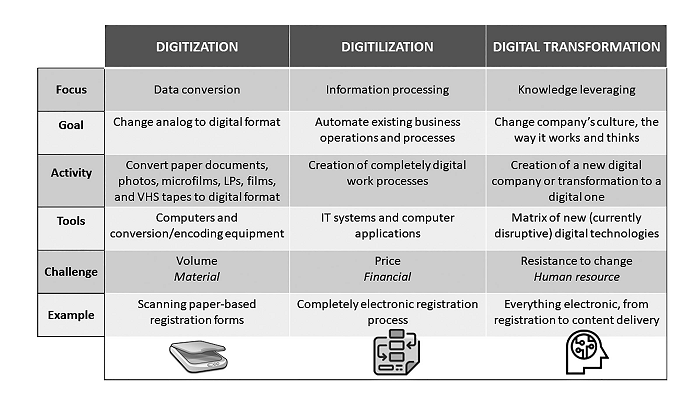At a recent library board meeting, which I had expected would proceed without a hitch, I was asked about our plans for the digital transformation of the library. Having just completed the digitization of a huge collection of legacy documents, along with the successful automation of a number of library functions using our newly acquired library management system, my first reaction was to reply that we had just completed such a transformation. After a brief pause, in which I inwardly battled confusion about a proper response, I replied that we were working on a digital transformation plan that would soon be submitted. Left unsaid was the fact that I would first need to find out why scanning and automation don’t qualify as digital transformation, and what the differences are among digitization, digitalization, and digital transformation.
Ma ny articles, blog posts, and comments have been written about the differences among these three terms, so you can rightfully ask why yet one more should be written. The reason is simple: because of the practical need that humans have to communicate clearly and to be properly understood. As my example in the previous paragraph demonstrates, confusion still exists about the meaning, scope, and use of these terms.
At one time, the terms were used almost interchangeably, especially the first two—digitization and digitalization—in which the difference in spelling is just two letters. Digital transformation is a somewhat newer and more easily understood term, although it still causes semantic confusion. Digital transformation attempts to rise above the terminological ambiguity by assuming an umbrella role, encompassing digitization and digitalization as its constituting components and regarding them as rather small, but necessary, steps in the big picture of an organization’s digital transformation.
Let’s dig deeper into several facets of the concepts covered by each term. For clarity, each term is reviewed through five facets: focus, goal, activity, tools, and challenges. The table below gives a brief summary, with examples of each facet.

Digitization: converting from analog to digital format
The rise of commercially available high-resolution (600 DPI or more) paper scanners in the late 1990s was a technical trigger for the mass conversion of analog data (paper archives) to digital format. The invention of the first compact disk (CD) in 1982 offered a cheap storage and distribution medium that was used not only for storing paper documents but also for the conversion of audio and video analog formats, such as LPs, cassettes, film reels, and VHS tapes. The digitization of microfilm and microfiche was also widespread at that time. This conversion did not perhaps bring about the promised longevity of new digital formats (TIFF, DjVu, PDF), but it did provide other benefits, such as usability, the speed of access, transferability, and the possibility of further processing.
A good example of this was the digitization effort of the International Nuclear Information System (INIS). Since its creation in 1970 until 1996, INIS collected and converted to microfiche more than 312,000 non-conventional literature (NCL) reports received from IAEA (International Atomic Energy Agency) member states and international organizations. The micro fiche collection contained more than 1 million items, with an estimated 25 million pages of full texts (dobrica.savic.ca/pubs/2013-GL15-DigPres-Savic-St-Pierre.pdf). This collection, after digitization, is now part of the online INIS repository (inis.iaea.org/search).
The example of INIS demonstrated several challenges of digitization, such as the volume of potential materials to be converted to a digital format, the provision of proper storage facilities, and adequate access to this facility by external users. Security and privacy became part of the regular technical and management agenda that had to be taken into consideration.